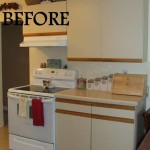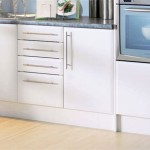How to Replace a Kitchen Sink Cabinet Bottom
The bottom of a kitchen sink cabinet is often the first to show signs of wear and tear. Water spills, leaks, and general moisture can cause the wood to rot, warp, or simply break down. When this happens, it’s time to replace the cabinet bottom. This process, while initially daunting, is achievable for most DIY enthusiasts with the right tools and knowledge.
Replacing a kitchen sink cabinet bottom is not merely an aesthetic improvement. It's a crucial step towards maintaining a functional and safe kitchen environment. A damaged or rotting cabinet bottom can lead to structural instability, making the sink prone to collapsing or even posing a health hazard. This article will guide you through the necessary steps to confidently replace the bottom of your kitchen sink cabinet.
Step 1: Gather Your Supplies and Tools
Before embarking on this task, ensure you have all the necessary tools and materials at hand. This will streamline the process and prevent unnecessary interruptions. You will need:
- A new cabinet bottom (ensure it’s the correct size and material for your cabinet)
- Wood screws (appropriate size and length for your cabinet material)
- Wood glue
- Screwdriver or drill (with appropriate bits)
- Measuring tape
- Level
- Saw (if you need to cut the new bottom to size)
- Safety gloves and eye protection
- A helper (optional, but highly recommended)
Step 2: Remove the Old Cabinet Bottom
The first step is to remove the existing cabinet bottom. This may involve a few steps depending on your cabinet’s construction:
- Remove the Sink: Carefully detach the sink from the countertop, taking note of the plumbing connections and any mounting hardware for re-installation.
- Remove Existing Fasteners: Locate and remove any screws, nails, or other fasteners holding the old cabinet bottom in place. Use a screwdriver or drill to carefully remove these, taking care not to damage the surrounding cabinet frame.
- Remove the Old Bottom: Once all the fasteners are removed, gently lift the old cabinet bottom out of the cabinet. If it’s stuck, you may need to pry it loose with a putty knife or similar tool, being careful not to damage the cabinet frame.
Step 3: Prepare the Cabinet for the New Bottom
Before installing the new cabinet bottom, it’s essential to prepare the cabinet for a smooth and secure fit:
- Clean the Cabinet Frame: Remove any debris, dust, or old adhesive residue from the cabinet frame where the new bottom will be attached. This ensures a clean, even surface for adhering the new bottom.
- Measure and Cut New Bottom (if needed): If your new cabinet bottom is not pre-cut to the exact size, use a measuring tape and saw to cut the new bottom to the correct dimensions. Make sure to measure accurately and cut precisely to avoid any gaps or uneven fits.
- Check for Fit: Before attaching the new bottom, double-check that it fits snugly and flush with the cabinet frame. You may need to make minor adjustments to ensure a perfect fit.
Step 4: Install the New Cabinet Bottom
Now that the cabinet is prepared, you can install the new bottom:
- Apply Wood Glue: Apply a generous layer of wood glue to the bottom edges of the new cabinet bottom. Be sure to spread the glue evenly across all surfaces that will be in contact with the cabinet frame.
- Position and Secure the Bottom: Gently slide the new bottom into the cabinet frame, ensuring it is flush with the sides and back. Use screws or nails (depending on your cabinet construction) to securely fasten the new bottom to the cabinet frame. Use a level to ensure the bottom is straight and even before driving in the screws or nails.
- Clean Up: Once the new bottom is installed, wipe away any excess glue with a damp cloth. Allow the glue to dry completely before proceeding to the next step.
Step 5: Reinstall the Sink and Plumbing
With the new cabinet bottom in place, you can now reinstall the sink and its plumbing. This step requires careful reassembly and attention to detail:
- Reinstall the Sink: Carefully place the sink back onto the countertop, ensuring it’s properly aligned with the plumbing connections. Attach the sink to the countertop using the original mounting hardware.
- Reconnect Plumbing: Reconnect the plumbing lines (hot and cold water supply lines, drain lines, and any associated hardware). Double-check all connections for leaks before turning on the water supply.
- Test for Leaks: Once the plumbing is reconnected, turn on the water supply and test for any leaks. If leaks are found, carefully re-tighten the connections or address any other plumbing issues.
Replacing a kitchen sink cabinet bottom is a straightforward process that can be tackled by most homeowners with basic DIY skills. By following these steps and taking your time, you can restore the integrity and functionality of your kitchen sink area and ensure a safe and aesthetically pleasing space for years to come.

How To Replace Rotted Sink Base Cabinet Floor Bottom Easy Home Mender

Under Sink Cabinet Repair Our Bright Road
When Repairing The Bottom Of Cabinet Below Kitchen Sink Do I Need To Take Damaged Section Out Or Can Simply Put Plywood On Top It Quora

Kitchen Sink Bottom Rotted

How To Replace Rotted Wood Under A Kitchen Sink Diy Guide Dengarden

How To Fix Rotted Cabinet Bottom Floor Much Sink Install House Remodeling Decorating Construction Energy Use Kitchen Bathroom Bedroom Building Rooms City Data Forum

We Repair Water Damaged Sink Base Cabinet Floor

How To Replace Rotted Sink Base Cabinet Floor Bottom Easy Home Mender

How To Replace A Kitchen Sink Base Cabinet Vevano

How Can I Replace A Kichen Island Sink Base Cabinet Hometalk
Related Posts








